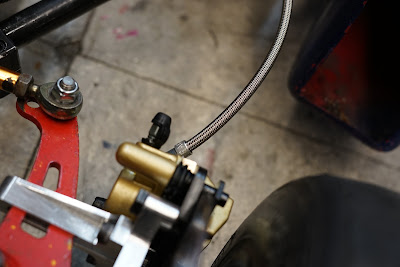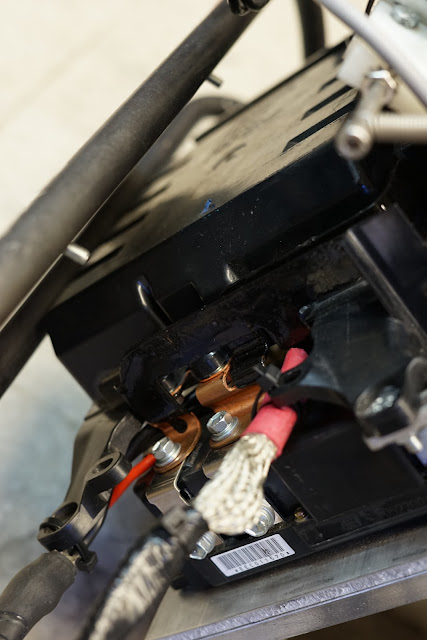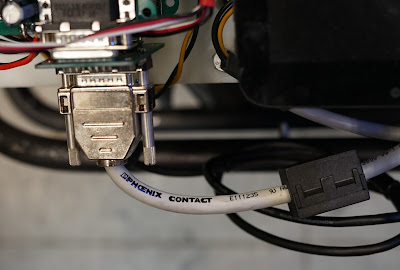We (Ben, Charles, Dane, myself) recently acquired a 2011 Hyundai Sonata battery pack to go with our Prius parts and Hyundai Sonata motors. The voltage (270V nominal) and capacity (1.4KWh) looked promising for medium-sized vehicles, the power capabilities were rather high (almost 60KW, according to INL), and the price was exceptional ($260 from LKQ for a 'B' grade one, $350 for an 'A' grade one).
Idaho National Laboratory had done some testing on the battery as part of the DOE AVTA program. The full report is
here, but the gist of it is:
- 72S 'Lithium Polymer' (3.75V nominal, 4.2V max)
- 5.3Ah (1.4KWh) capacity
- 400mohm pack resistance, ~5mohm per cell
- 60KW peak source (at full charge, 40C), 46KW peak sink (at full empty, 30C)
- 46KW average source (30C), 30KW average sink (20C)
5mohm on a 5.3Ah cell is not bad, on par with the best ("60C") R/C batteries on the market. The complete pack was rather heavy, but hopefully we could shed half or more of that weight by removing the steel armor. Without further ado, let's dig in!
The first thing everyone seems to notice: the enormous blower cooling the pack. Hyundai is very proud of its air-cooled pack design, and boy is that a mighty blower. I wasn't personally interested in the fan, but it could be useful for long-term traction duty.
Ignoring several ominous warnings and removing the HV safety cover, we are greeted by the contactor assembly (more on that later), and...
...the BMS! This one is interesting enough that we'll investigate more at the end of the post.
Moving on, lifting the main cover off the pack reveals the guts of the battery:
It's hard to tell from the photo, but the big silver bars (two on top, one underneath the modules) hold the pack in compression via the end-plates, which are padded with high-density foam.
The modules bear a 'GreenPower' label; there are several power companies going by that name, but none of them seem to make hybrid batteries.
Removing a few dozen screws and unplugging the balance connectors liberates the modules. Not shown: make sure to remove the safety disconnect before servicing the pack internals!
The modules are conveniently sized; each one is 8S/5.3Ah and weighs a hair over 2.5kg (2.6, to be exact). Sadly there is a whole lot of empty space in each module, presumably for airflow, and as a result energy density is quite poor.
Moving on to the contactor box, undoing a large number of plastic snaps reveals two adorable little 400VDC/80A contactors:
I have no idea how they get 35KW through an 80A contactor...
A Detour: the BMS
The BMS is remarkably straightforward inside - in fact, entirely made of off-the-shelf components.
The big IC is a
microcontroller. The good news? It has a datasheet! The bad? It is some sort of godforsaken Infineon part, built on a custom uArch and costing $22
Come on guys, how hard is it to use an ARM?
The actual balancing assemblies are built around the
LTC6802 stackable battery monitor. Each chip monitors its own module, resulting in nine chips daisy-chained into each other.
Communication across the LV/HV isolation barrier happens via a pair of Texas Instruments
ISO7241C digital isolators, powered by a pair of 1W board-mount DC-DC converters made by Mornsun (I've never heard of them? Have you?). These seem to be clones of the popular CUI 1W modules.
The strange-looking package above the micro is an Infineon
TLE6220 - some sort of SPI-controlled switch for controlling the precharge and main contactors.
THE VERDICT
The good:
- Rather low ESR and high discharge ratings - 40C peak for 10s is about as good as anything gets.
- Convenient packaging; modules are a reasonable voltage and capacity and constrain the prismatics to some extent, requiring only a simple external clamp to maintain compression.
- BMS is built out of off-the-shelf components, giving some hope for reverse-engineering and/or reprogramming.
- Very cheap; the equivalent pack from a Chinese hobby vendor would be well over a thousand dollars.
The bad:
- Very poor energy density, a quarter that of a standard LiPo and half that of a bare A123 pack.
- Can't reach 48V nominal using the modules.
Overall, not a pack for battlebots or flying things, but for weight-insensitive applications the price, power, and convenience pretty much can't be beat as of now (early 2017).














































